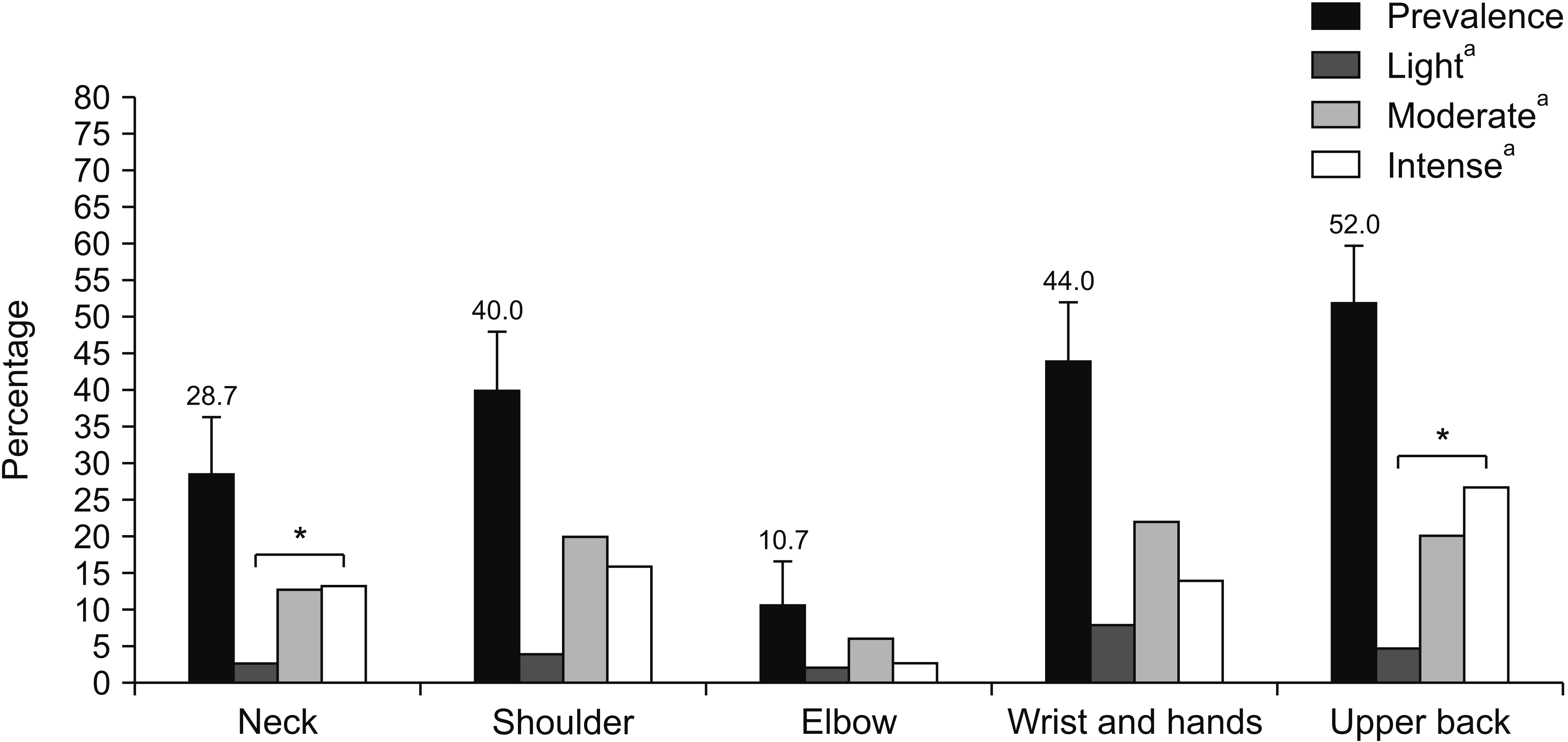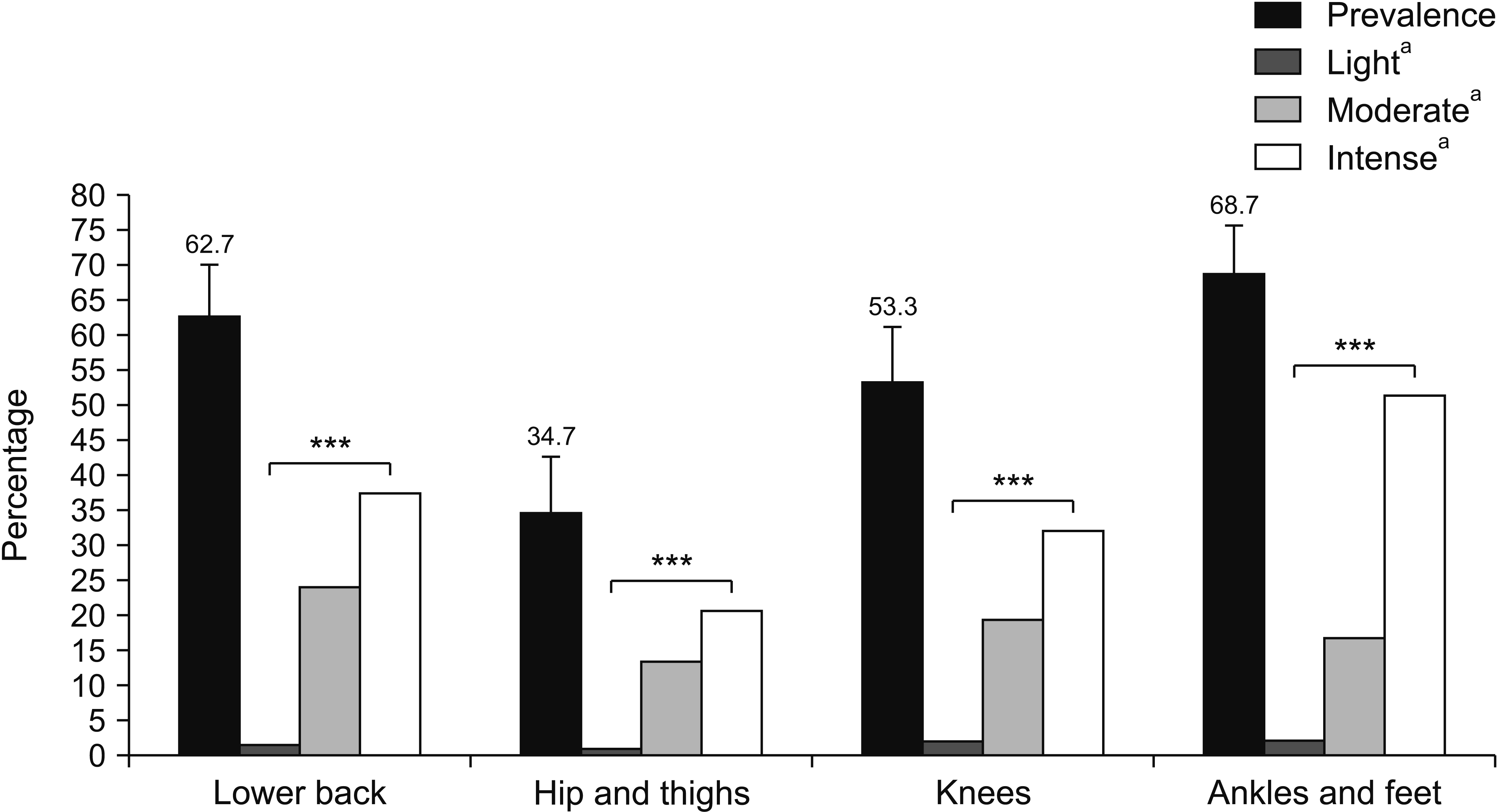2. Arbex AK, Rocha DR, Aizenberg M, Ciruzzi MS. 2014; Obesity epidemic in Brazil and Argentina: a public health concern. J Health Popul Nutr. 32:327–34. PMID:
25076669. PMCID:
PMC4216968.
3. Bihari V, Kesavachandran C, Pangtey BS, Srivastava AK, Mathur N. 2011; Musculoskeletal pain and its associated risk factors in residents of National Capital Region. Indian J Occup Environ Med. 15:59–63. DOI:
10.4103/0019-5278.90375. PMID:
22223951. PMCID:
PMC3249791.

4. Stone AA, Broderick JE. 2012; Obesity and pain are associated in the United States. Obesity (Silver Spring). 20:1491–5. DOI:
10.1038/oby.2011.397. PMID:
22262163.

6. MacLellan GA, Dunlevy C, O'Malley E, Blake C, Breen C, Gaynor K, et al. 2017; Musculoskeletal pain profile of obese individuals attending a multidisciplinary weight management service. Pain. 158:1342–53. DOI:
10.1097/j.pain.0000000000000918. PMID:
28383311.

7. Hashimoto Y, Matsudaira K, Sawada SS, Gando Y, Kawakami R, Kinugawa C, et al. 2017; Obesity and low back pain: a retrospective cohort study of Japanese males. J Phys Ther Sci. 29:978–83. DOI:
10.1589/jpts.29.978. PMID:
28626304. PMCID:
PMC5468219.

8. Santos ASAC, Rodrigues APS, Rosa LPS, Sarrafzadegan N, Silveira EA. 2020; Cardiometabolic risk factors and Framingham Risk Score in severely obese patients: baseline data from DieTBra trial. Nutr Metab Cardiovasc Dis. 30:474–82. DOI:
10.1016/j.numecd.2019.10.010. PMID:
31791637.

9. Rodrigues APS, Rosa LPS, Silveira EA. 2018; PPARG2 Pro12Ala polymorphism influences body composition changes in severely obese patients consuming extra virgin olive oil: a randomized clinical trial. Nutr Metab (Lond). 15:52. DOI:
10.1186/s12986-018-0289-4. PMID:
30026785. PMCID:
PMC6050653.

10. Associação Brasileira de Empresas de Pesquisa (ABEP). 2012. Critério de classificação econômica Brasil [Internet]. Associação Brasileira de Empresas de Pesquisa (ABEP);São Paulo: Available at:
http://www.abep.org/Servicos/Download.aspx?.id=03.
12. Thompson FE, Subar AF. Coulston AM, Boushey CJ, editors. 2008. Dietary assessment methodology. Nutrition in the prevention and treatment of disease. 2nd ed. Academic Press;San Diego:

14. American Diabetes Association. 2017; Standards of medical care in diabetes-2017 abridged for primary care providers. Clin Diabetes. 35:5–26. DOI:
10.2337/cd16-0067. PMID:
28144042. PMCID:
PMC5241768.
15. WHO Collaborating Centre for Drug Statistics Methodology. 2018. ATC/DDD index 2018 [Internet]. WHO Collaborating Centre for Drug Statistics Methodology;Oslo: Available at:
https://www.whocc.no/atc_ddd_index/.
16. Jin M, Yang F, Yang I, Yin Y, Luo JJ, Wang H, et al. 2012; Uric acid, hyperuricemia and vascular diseases. Front Biosci (Landmark Ed). 17:656–69. DOI:
10.2741/3950. PMID:
22201767.

17. Colgrove KC. 2016. Med-surg success: a Q&A review applying critical thinking to test taking. 3rd ed. F.A. Davis;Philadelphia:
18. Xavier HT, Izar MC, Faria Neto JR, Assad MH, Rocha VZ, Sposito AC, et al. 2013; [V Brazilian guidelines on dyslipidemias and prevention of atherosclerosis]. Arq Bras Cardiol. 101(4 Suppl 1):1–20. Portuguese. DOI:
10.5935/abc.2013S010. PMID:
24217493.
19. Lohman TG, Roche AF, Martorell R. 1988. Anthropometric standardization reference manual. . Human Kinetics Books;Champaign:

20. World Health Organization (WHO). 2000. Obesity: preventing and managing the global epidemic. . Geneva:
21. Pinheiro FA, Tróccoli BT, Carvalho CV. 2002; [Validity of the Nordic Musculoskeletal Questionnaire as morbidity measurement tool]. Rev Saude Publica. 36:307–12. Portuguese. DOI:
10.1590/S0034-89102002000300008. PMID:
12131969.
22. Mendonça CR, Noll M, Silveira EA. 2018; Adaptation and validation of body maps for musculoskeletal pain location in patients with severe obesity. Korean J Pain. 31:268–76. DOI:
10.3344/kjp.2018.31.4.268. PMID:
30310552. PMCID:
PMC6177535.

23. Kuorinka I, Jonsson B, Kilbom A, Vinterberg H, Biering-S©ªrensen F, Andersson G, et al. 1987; Standardised Nordic questionnaires for the analysis of musculoskeletal symptoms. Appl Ergon. 18:233–7. DOI:
10.1016/0003-6870(87)90010-X.

24. Boonstra AM, Stewart RE, Köke AJ, Oosterwijk RF, Swaan JL, Schreurs KM, et al. 2016; Cut-off points for mild, moderate, and severe pain on the numeric rating scale for pain in patients with chronic musculoskeletal pain: variability and influence of sex and catastrophizing. Front Psychol. 7:1466. DOI:
10.3389/fpsyg.2016.01466. PMID:
27746750. PMCID:
PMC5043012.

25. Greenland S, Daniel R, Pearce N. 2016; Outcome modelling strategies in epidemiology: traditional methods and basic alternatives. Int J Epidemiol. 45:565–75. DOI:
10.1093/ije/dyw040. PMID:
27097747. PMCID:
PMC4864881.

26. Peduzzi P, Concato J, Kemper E, Holford TR, Feinstein AR. 1996; A simulation study of the number of events per variable in logistic regression analysis. J Clin Epidemiol. 49:1373–9. DOI:
10.1016/S0895-4356(96)00236-3.

27. Calenzani G, Santos FFD, Wittmer VL, Freitas GKF, Paro FM. 2017; Prevalence of musculoskeletal symptoms in obese patients candidates for bariatric surgery and its impact on health related quality of life. Arch Endocrinol Metab. 61:319–25. DOI:
10.1590/2359-3997000000237. PMID:
28225991.

28. Brady SR, Mamuaya BB, Cicuttini F, Wluka AE, Wang Y, Hussain SM, et al. 2015; Body composition is associated with multisite lower body musculoskeletal pain in a community-based study. J Pain. 16:700–6. DOI:
10.1016/j.jpain.2015.04.006. PMID:
25958316.

29. Evanoff A, Sabbath EL, Carton M, Czernichow S, Zins M, Leclerc A, et al. 2014; Does obesity modify the relationship between exposure to occupational factors and musculoskeletal pain in men? Results from the GAZEL cohort study. PLoS One. 9:e109633. DOI:
10.1371/journal.pone.0109633. PMID:
25330397. PMCID:
PMC4201453.

30. Hashimoto Y, Matsudaira K, Sawada SS, Gando Y, Kawakami R, Sloan RA, et al. 2018; Association between objectively measured physical activity and body mass index with low back pain: a large-scale cross-sectional study of Japanese men. BMC Public Health. 18:341. DOI:
10.1186/s12889-018-5253-8. PMID:
29523128. PMCID:
PMC5845261.

31. Koçyiğit BF, Okyay RA. 2018; The relationship between body mass index and pain, disease activity, depression and anxiety in women with fibromyalgia. PeerJ. 6:e4917. DOI:
10.7717/peerj.4917. PMID:
29868295. PMCID:
PMC5978395.

32. Faghri PD, Chin WS, Huedo-Medina TB. 2015; The link between musculoskeletal pain, lifestyle behaviors, exercise self-efficacy, and quality of life in overweight and obese individuals. Int J Phys Med Rehabil. 3:255. DOI:
10.4172/2329-9096.1000255. PMID:
29250572. PMCID:
PMC5730077.

33. Hitt HC, McMillen RC, Thornton-Neaves T, Koch K, Cosby AG. 2007; Comorbidity of obesity and pain in a general population: results from the Southern Pain Prevalence Study. J Pain. 8:430–6. DOI:
10.1016/j.jpain.2006.12.003. PMID:
17337251.

34. Yoo JJ, Cho NH, Lim SH, Kim HA. 2014; Relationships between body mass index, fat mass, muscle mass, and musculoskeletal pain in community residents. Arthritis Rheumatol. 66:3511–20. DOI:
10.1002/art.38861. PMID:
25185757.

35. Park IY, Cho NH, Lim SH, Kim HA. 2018; Gender-specific associations between fat mass, metabolic syndrome and musculoskeletal pain in community residents: a three-year longitudinal study. PLoS One. 13:e0200138. DOI:
10.1371/journal.pone.0200138. PMID:
29985938. PMCID:
PMC6037368.

36. Masheb RM, White MA, Grilo CM. 2016; Sex differences and correlates of pain in patients with comorbid obesity and binge eating disorder. Eur Eat Disord Rev. 24:247–50. DOI:
10.1002/erv.2432. PMID:
26841114. PMCID:
PMC4821688.

37. Adeniyi AF, Sanya AO, Fasanmade AA, Borodo M, Uloko AE. 2010; Relationship between duration of diagnosis and neuromusculoskeletal complications of middle-aged type 2 diabetes patients. West Afr J Med. 29:393–7. DOI:
10.4314/wajm.v29i6.68274. PMID:
21465447.

38. Velázquez-Rueda ML, Hernández-Méndez-Villamil E, Mendoza-Muñoz M, Rivas-Montero JA, Espinosa-Gutiérrez A. 2018; [Strength and function of hand before and after release of carpal tunnel in patients with type 2 diabetes mellitus by open and endoscopic approach. Case-control study]. Acta Ortop Mex. 32:22–7. Spanish. PMID:
30182542.
39. Oktayoglu P, Nas K, Kilinç F, Tasdemir N, Bozkurt M, Yildiz I. 2015; Assessment of the presence of carpal tunnel syndrome in patients with diabetes mellitus, hypothyroidism and acromegaly. J Clin Diagn Res. 9:OC14–8. DOI:
10.7860/JCDR/2015/13149.6101. PMID:
26266148. PMCID:
PMC4525537.

40. Duclos M. 2016; Osteoarthritis, obesity and type 2 diabetes: the weight of waist circumference. Ann Phys Rehabil Med. 59:157–60. DOI:
10.1016/j.rehab.2016.04.002. PMID:
27211819.

42. Stefansdottir R, Gudmundsdottir SL. 2017; Sedentary behavior and musculoskeletal pain: a five-year longitudinal Icelandic study. Public Health. 149:71–3. DOI:
10.1016/j.puhe.2017.04.019. PMID:
28558304.

43. Vancampfort D, Stubbs B, Koyanagi A. 2017; Physical chronic conditions, multimorbidity and sedentary behavior amongst middle-aged and older adults in six low- and middle-income countries. Int J Behav Nutr Phys Act. 14:147. DOI:
10.1186/s12966-017-0602-z. PMID:
29078781. PMCID:
PMC5658996.

44. Stubbs B, Patchay S, Soundy A, Schofield P. 2014; The avoidance of activities due to fear of falling contributes to sedentary behavior among community-dwelling older adults with chronic musculoskeletal pain: a multisite observational study. Pain Med. 15:1861–71. DOI:
10.1111/pme.12570. PMID:
25224385.

46. Taylor SS, Hughes JM, Coffman CJ, Jeffreys AS, Ulmer CS, Oddone EZ, et al. 2018; Prevalence of and characteristics associated with insomnia and obstructive sleep apnea among veterans with knee and hip osteoarthritis. BMC Musculoskelet Disord. 19:79. DOI:
10.1186/s12891-018-1993-y. PMID:
29523117. PMCID:
PMC5845198.

47. Leung YY, Huebner JL, Haaland B, Wong SBS, Kraus VB. 2017; Synovial fluid pro-inflammatory profile differs according to the characteristics of knee pain. Osteoarthritis Cartilage. 25:1420–7. DOI:
10.1016/j.joca.2017.04.001. PMID:
28433814.

48. Parimi N, Blackwell T, Stone KL, Lui LY, Ancoli-Israel S, Tranah GJ, et al. 2012; Hip pain while using lower extremity joints and sleep disturbances in elderly white women: results from a cross-sectional analysis. Arthritis Care Res (Hoboken). 64:1070–8. DOI:
10.1002/acr.21630. PMID:
22298286. PMCID:
PMC3355201.
49. Gay A, Culliford D, Leyland K, Arden NK, Bowen CJ. 2014; Associations between body mass index and foot joint pain in middle-aged and older women: a longitudinal population-based cohort study. Arthritis Care Res (Hoboken). 66:1873–9. DOI:
10.1002/acr.22408. PMID:
25047683. PMCID:
PMC4282113.

50. Walsh TP, Arnold JB, Evans AM, Yaxley A, Damarell RA, Shanahan EM. 2018; The association between body fat and musculoskeletal pain: a systematic review and meta-analysis. BMC Musculoskelet Disord. 19:233. DOI:
10.1186/s12891-018-2137-0. PMID:
30021590. PMCID:
PMC6052598.





 PDF
PDF Citation
Citation Print
Print





 XML Download
XML Download